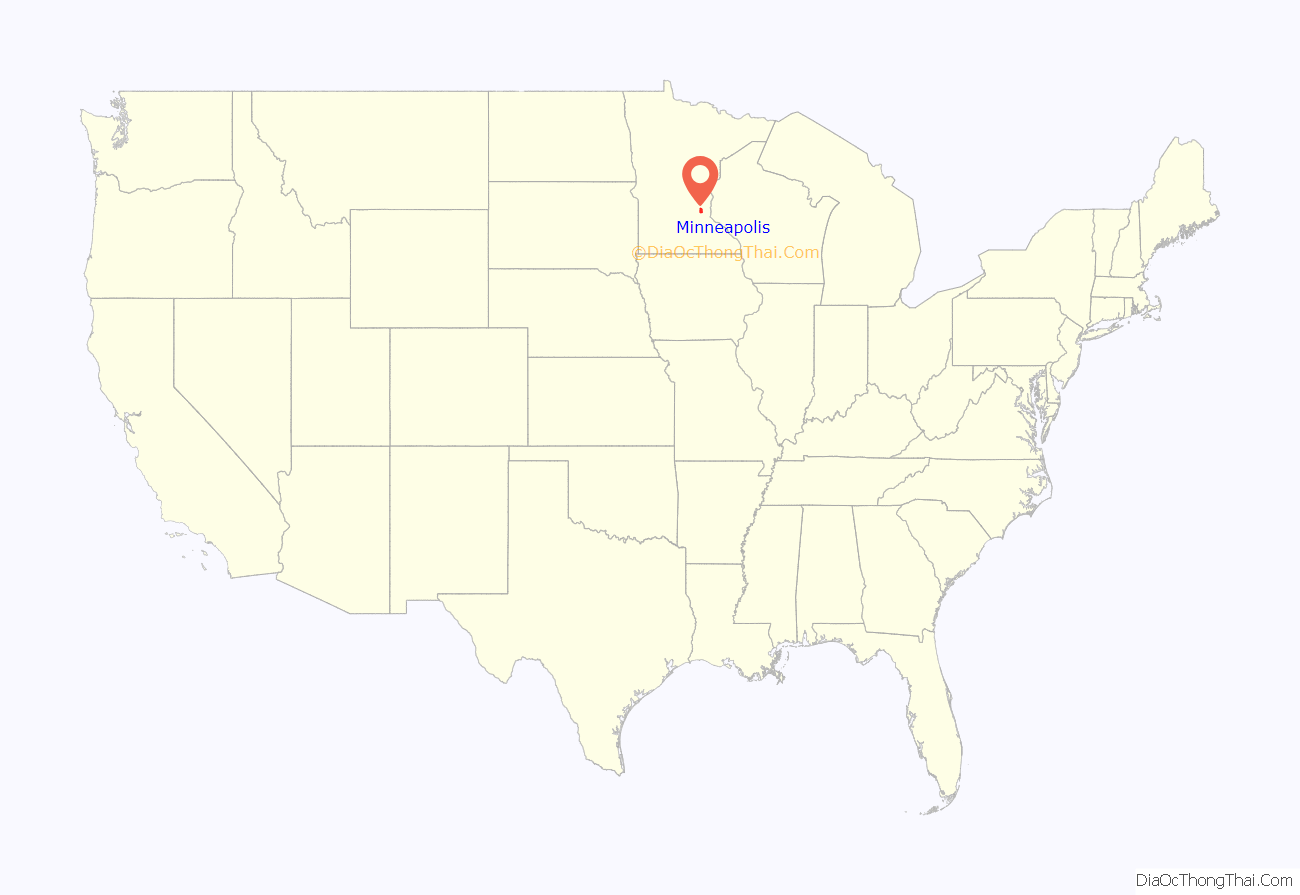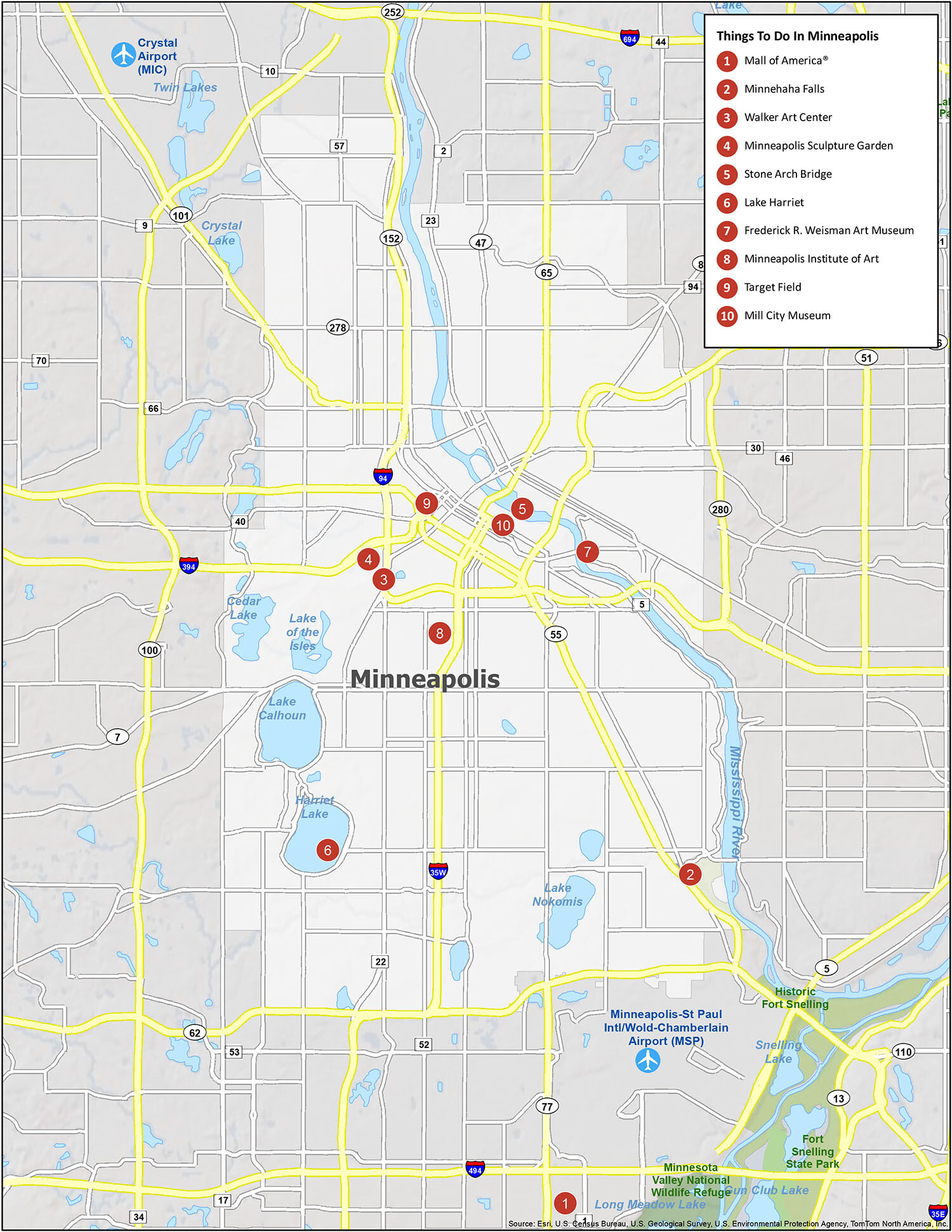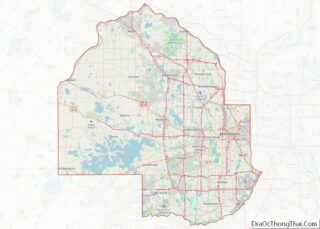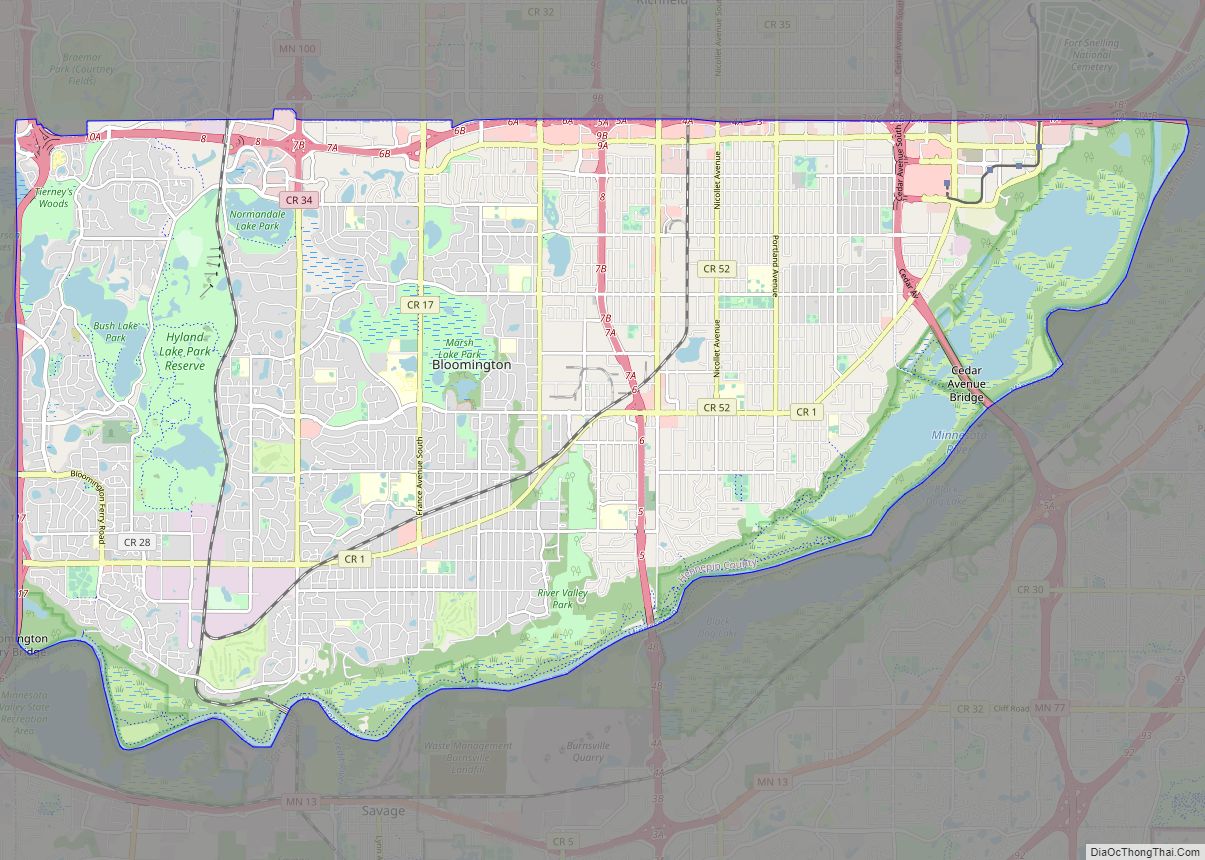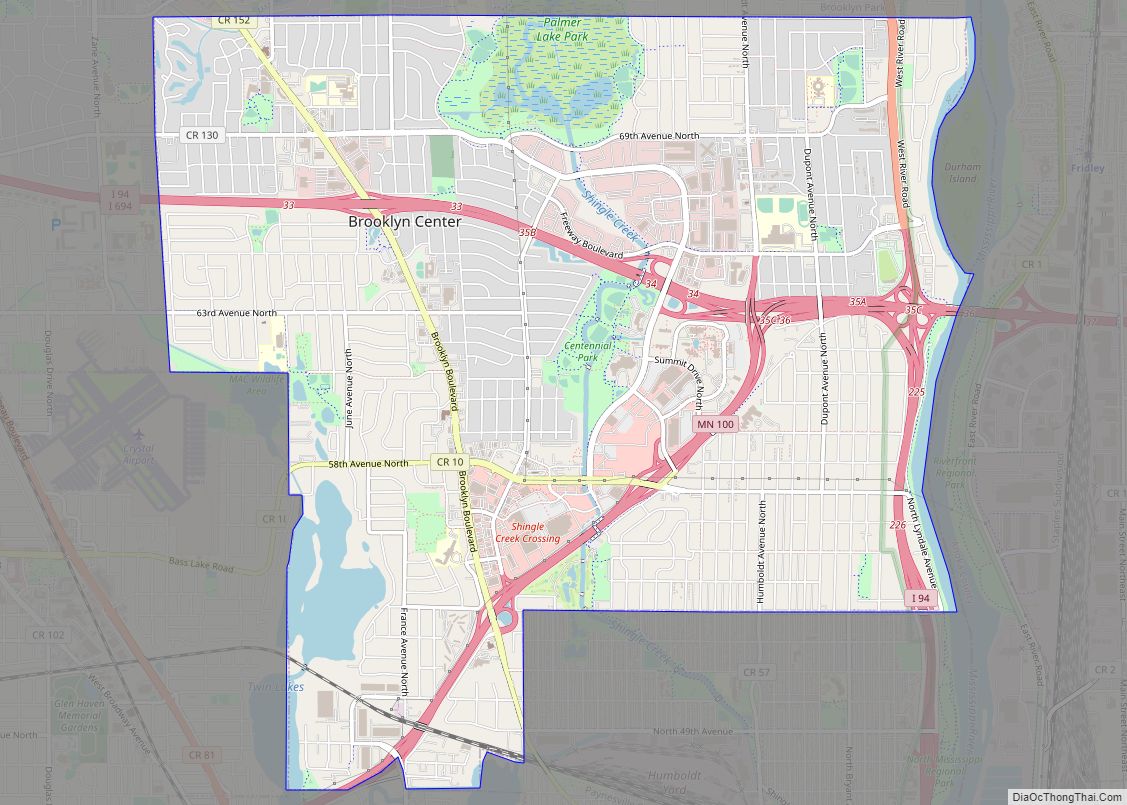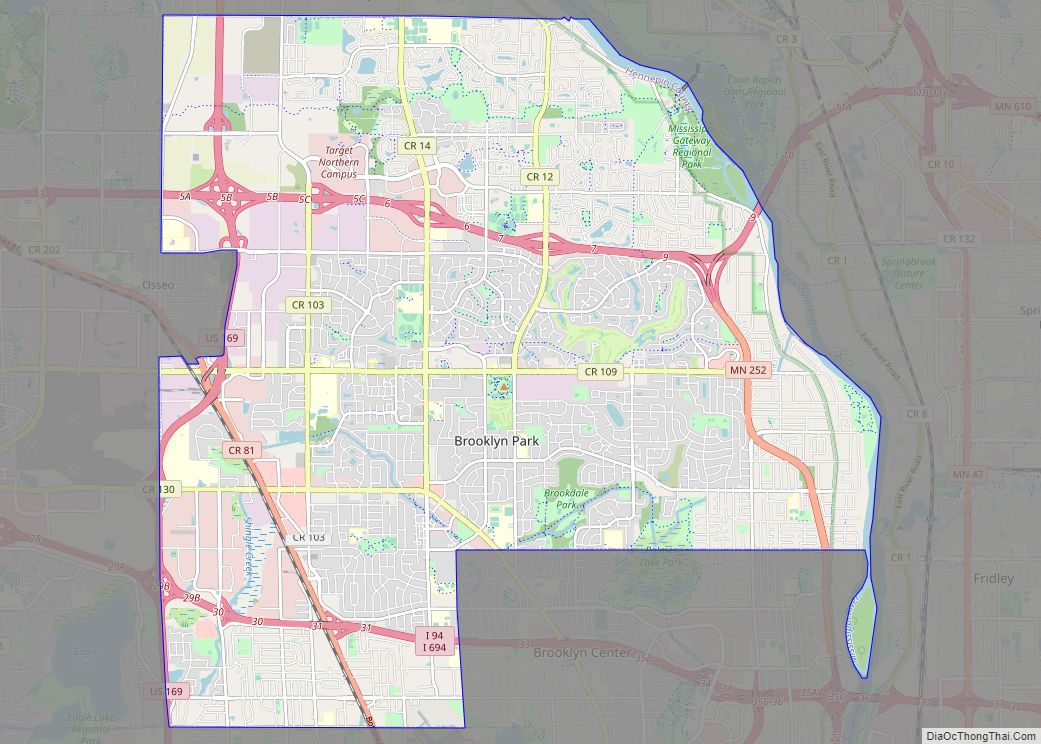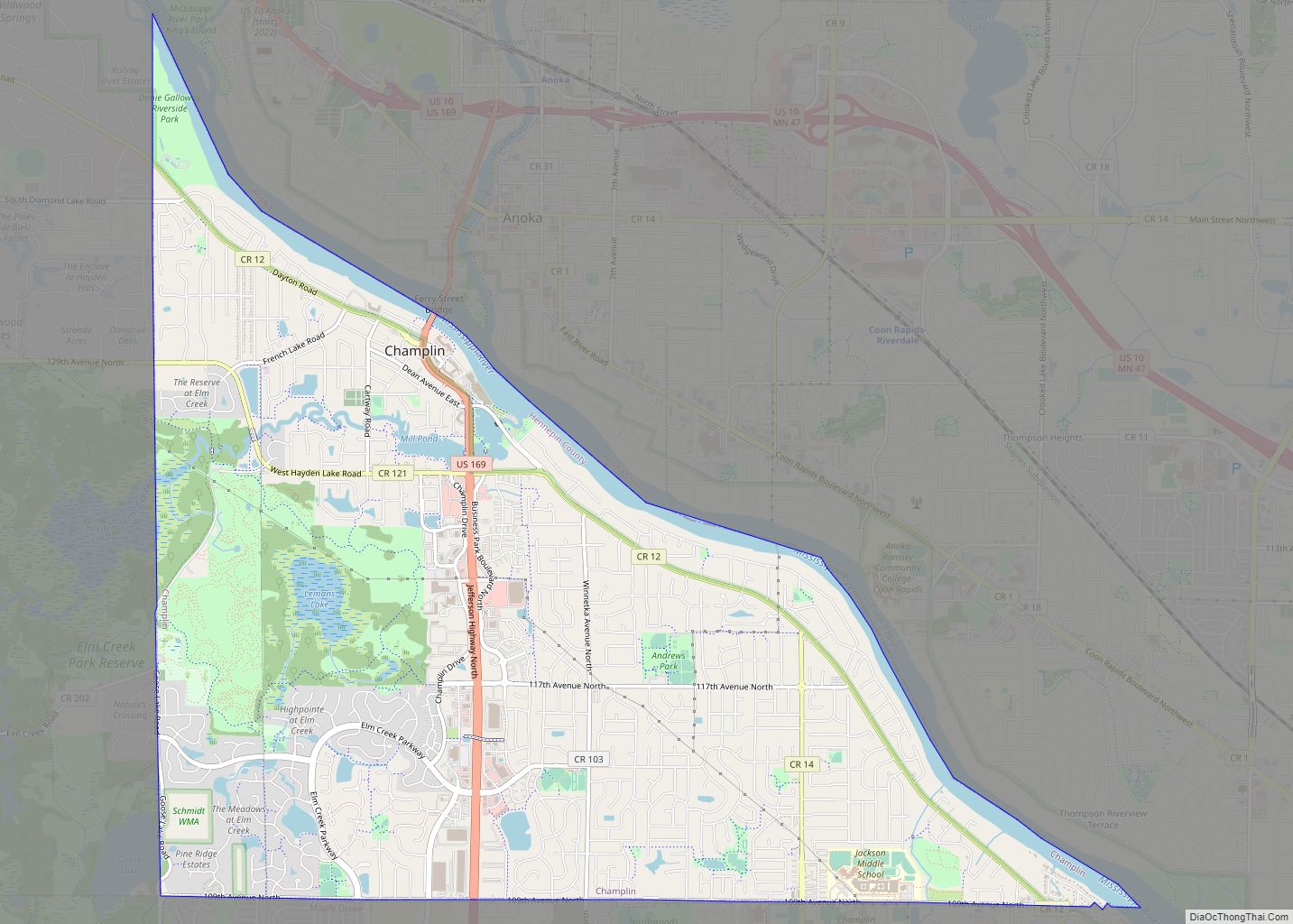Minneapolis (/ˌmɪniˈæpəlɪs/ (listen) MIN-ee-AP-əl-iss), officially the City of Minneapolis, is a city in the state of Minnesota and the county seat of Hennepin County. As of the 2020 census the population was 429,954, making it the largest city in Minnesota and the 46th-most-populous in the United States. Nicknamed the “City of Lakes”, Minneapolis is abundant in water, with thirteen lakes, wetlands, the Mississippi River, creeks, and waterfalls. Minneapolis has its origins as the 19th century lumber and flour milling capitals of the world, and, to the present day, preserved its financial clout. It occupies both banks of the Mississippi River and adjoins Saint Paul, the state capital of Minnesota.
Before European settlement, the site of Minneapolis was inhabited by Dakota people. The settlement was founded along Saint Anthony Falls—the only natural waterfall on the entire length of the Mississippi River—on a section of land north of Fort Snelling. Its growth is attributed to its proximity to the fort and the falls providing power for industrial activity. Minneapolis, Saint Paul, and the surrounding area are collectively known as the Twin Cities, a metropolitan area home to 3.69 million inhabitants.
Minneapolis has one of the most extensive public park systems in the U.S.; many of these parks are connected by the Grand Rounds National Scenic Byway. Biking and walking trails run through many parts of the city including the Mississippi National River and Recreation Area, Boom Island Park, Lake of the Isles, Bde Maka Ska, and Lake Harriet, and Minnehaha Falls. Minneapolis has cold, snowy winters and warm, humid summers. A metropolis located far from competing neighbors, Minneapolis is the birthplace of General Mills, the Pillsbury brand, and the Target Corporation. The city’s cultural offerings include the Minneapolis Institute of Art, the First Avenue nightclub, and four professional sports teams.
Minneapolis is home to University of Minnesota’s main campus. The city’s public transport is provided by Metro Transit and the international airport, serving the Twin Cities region, is located towards the south on the city limits.
The city’s reputation for high quality of life notwithstanding, the striking disparities among the city’s population may be the most significant issue facing 21st century Minneapolis. Minneapolis has a mayor-council government system. The Minnesota Democratic–Farmer–Labor Party (DFL) holds a majority of the council seats and Jacob Frey has been mayor since 2018.
| Name: | Minneapolis city |
|---|---|
| LSAD Code: | 25 |
| LSAD Description: | city (suffix) |
| State: | Minnesota |
| County: | Hennepin County |
| Incorporated: | 1867 |
| Elevation: | 830 ft (250 m) |
| Land Area: | 54.00 sq mi (139.86 km²) |
| Water Area: | 3.51 sq mi (9.08 km²) |
| Population Density: | 7,962.11/sq mi (3,074.21/km²) |
| Area code: | 612 |
| FIPS code: | 2743000 |
| Website: | MinneapolisMN.gov |
Discover this Minneapolis map with roads, places of interest, and a list of things to do. Using this interactive map, you can explore the city of Minneapolis, which forms the Twin Cities with St. Paul, Minnesota. The city is famously known as the “City of Lakes” and is the most populous city in the state of Minnesota with 430,000 people. Split by the Mississippi River, the city is located in the eastern region of Minnesota, near the border of Wisconsin.
Minneapolis is a great destination to visit if you’re looking for a place that offers a unique combination of culture, nature, and urban living. Plus, the Mall of America is located in Bloomington, Minnesota – just south of the city. With this interactive map, you can easily explore the city to find the best places to visit, roads, and other points of interest.
Online Interactive Map
Click on ![]() to view map in "full screen" mode.
to view map in "full screen" mode.
Minneapolis has a strong cultural scene, with several fine museums and plenty of events. Plus, it has many high-office buildings in the downtown area with a vibrant nightlife. But it’s also a great place to explore the nearby countryside, with hiking trails and great places to explore like one of its 10,000 lakes. This interactive map gives you a good overview of the city and its major attractions, allowing you to plan your day accordingly.
Minneapolis location map. Where is Minneapolis city?
History
Dakota natives, city founded
Before European settlement, the Dakota Sioux were the sole occupants of the site of modern-day Minneapolis. In the Dakota language, the city’s name is Bde Óta Othúŋwe (‘Many Lakes Town’). The French explored the region in 1680. Gradually, more European-American settlers arrived, competing with the Dakota for game and other natural resources. Ending the Revolutionary War, the 1783 Treaty of Paris gave British-claimed territory east of the Mississippi River to the United States. In 1803, the US acquired land to the west of the Mississippi from France in the Louisiana Purchase. In 1819, the US Army built Fort Snelling at the southern edge of present-day Minneapolis to direct Native American trade away from British-Canadian traders, and to deter warring between the Dakota and Ojibwe in northern Minnesota. The fort attracted traders, settlers and merchants, spurring growth in the surrounding region. At the fort, agents of the St. Peters Indian Agency enforced the US policy of assimilating Native Americans into European-American society, encouraging them to give up subsistence hunting and cultivate the land. Missionaries encouraged Native Americans to convert from their religion to Christianity.
The US government pressed the Dakota to sell their land, which they ceded in a series of treaties that were negotiated by corrupt officials. In the decades following the signings of these treaties, their terms were rarely honored. During the American Civil War, officials plundered annuities promised to Native Americans, leading to famine among the Dakota. In 1862, a faction of the Dakota who were facing starvation declared war and killed settlers. The Dakota were interned and exiled from Minnesota. While the Dakota were being expelled, Franklin Steele laid claim to the east bank of Saint Anthony Falls, and John H. Stevens built a home on the west bank. Residents had divergent ideas on names for their community. In 1852, Charles Hoag proposed combining the Dakota word for ‘water’ (mni) with the Greek word for ‘city’ (polis), yielding Minneapolis. In 1851 after a meeting of the Minnesota Territorial Legislature, leaders of east bank St. Anthony lost their bid to move the capital from Saint Paul. In a close vote, Saint Paul and Stillwater agreed to divide the federal funding between them: Saint Paul would be the capital, while Stillwater would build the prison. The St. Anthony contingent eventually won the state university. In 1855 with a charter from the legislature, Steele and associates opened the first bridge across the Mississippi; the toll bridge cost pedestrians three cents (five cents round trip). In 1856, the territorial legislature authorized Minneapolis as a town on the Mississippi’s west bank. Minneapolis was incorporated as a city in 1867, and in 1872, it merged with St. Anthony.
Lumber, waterpower, and flour milling
Minneapolis’s two founding industries—lumber and flour milling—developed in the 19th century concurrently. Flour milling overshadowed lumber by some decades; nevertheless, both came to prominence for about fifty years, and the magnitude of both industries extended beyond state borders—in the end, to the nation and the globe. A lumber industry was built around forests in northern Minnesota, largely by lumbermen emigrating from Maine‘s depleting forests. The city’s first commercial sawmill was built in 1848, and the first gristmill in 1849. Towns built in western Minnesota with Minneapolis lumber shipped their wheat back to the city for milling.
The region’s waterways were used to transport logs well after railroads developed; the Mississippi River carried logs to St. Louis until the early 20th century. In 1871, of the thirteen mills sawing lumber in St. Anthony, eight ran on water power and five ran on steam turbines. Minneapolis supplied the materials for farmsteads and settlement of rapidly expanding cities on the prairies that lacked wood. White pine milled in the city built Miles City, Montana; Bismarck, North Dakota; Sioux Falls, South Dakota; Omaha, Nebraska; and Wichita, Kansas.
Minneapolis developed around Saint Anthony Falls, the highest waterfall on the Mississippi, which was used as a source of energy. By 1871, the river’s west bank had businesses including flour mills, woolen mills, iron works, a railroad machine shop, and mills for cotton, paper, sashes and wood-planing. Due to the occupational hazards of milling, by the 1890s, six companies manufactured artificial limbs. Grain grown in the Great Plains was shipped by rail to the city’s 34 flour mills. A 1989 Minnesota Archaeological Society analysis of the Minneapolis riverfront describes the use of water power in Minneapolis between 1880 and 1930 as “the greatest direct-drive waterpower center the world has ever seen”. Minneapolis was given the nickname “Mill City.”
An 1867 court case allowed digging the Eastman tunnel under the river at Nicollet Island. In 1869, a leak soon sucked the 6 ft (1.8 m) tailrace into a 90 ft (27 m)-wide chasm. Community-led repairs failed and in 1870, several buildings and mills fell into the river. For years, the US Army Corps of Engineers struggled to close the gap with timber until their concrete dike held in 1876.
The entrepreneurial founder of the company that became General Mills, Cadwallader C. Washburn adopted three technological innovations that added efficiency, speed, and safety to flour milling. Simple grist mills were revolutionized into modern machinery: middlings purifiers blew out the husks that had colored white flour, gradual reduction by steel and porcelain roller mills combined gluten with starch, and the Berhns Millstone Exhaust System decreased the risk of explosion by reducing the amount of flour dust in the air. William Dixon Gray developed some ideas and William de la Barre acquired others through industrial espionage in Hungary. Charles Alfred Pillsbury and the C. A. Pillsbury Company across the river hired Washburn employees and soon began using the new methods. The hard red spring wheat grown in Minnesota became valuable ($0.50 profit per barrel in 1871 increased to $4.50 in 1874), and Minnesota “patent” flour was recognized at the time as the best in the world. Later consumers discovered value in the bran that ” … Minneapolis flour millers routinely dumped” into the Mississippi. A single mill at Washburn-Crosby could make enough flour for 12 million loaves of bread each day and by 1900, fourteen percent of America’s grain was milled in Minneapolis. By 1895, through the efforts of silent partner William Hood Dunwoody, Washburn-Crosby exported four million barrels of flour a year to the United Kingdom. When exports reached their peak in 1900, about one third of all flour milled in Minneapolis was shipped overseas.
Social tensions
In 1886, when Martha Ripley founded Maternity Hospital for both married and unmarried mothers, Minneapolis made changes to rectify discrimination against unmarried women. Known initially as a kindly physician, mayor Doc Ames made his brother police chief, ran the city into corruption, and tried to leave town in 1902. Lincoln Steffens published Ames’s story in “The Shame of Minneapolis” in 1903. The Ku Klux Klan entered family life but was only effectively a force in the city from 1921 until 1923. The gangster Kid Cann engaged in bribery and intimidation between the 1920s and the 1940s. After Minnesota passed a eugenics law in 1925, the proprietors of Eitel Hospital sterilized people at Faribault State Hospital.
With a Black population of less than one percent, the city was relatively unsegregated before 1910, when a developer wrote the first restrictive covenant based on race and ethnicity into a Minneapolis deed. But then realtors adopted the practice, thousands of times preventing non-Whites from owning or leasing properties, and they continued for four decades until the city became more and more racially divided. Such language was prohibited by state law in 1953 and by the federal Fair Housing Act of 1968.
During the financial downturn of the Great Depression, the violent Teamsters Strike of 1934 led to laws acknowledging workers’ rights.
Between 1958 and 1963, as part of urban renewal in America, Minneapolis demolished roughly 40 percent of downtown, including the Gateway District and its significant architecture, such as the Metropolitan Building. Efforts to save the building failed but encouraged interest in historic preservation.
From the end of World War I in 1918 until 1950, antisemitism was commonplace in Minneapolis—Carey McWilliams called the city the anti-Semitic capital of the United States. A hate group called the Silver Legion of America held meetings in the city from 1936 to 1938. In the 1940s, mayor Hubert Humphrey worked to rescue the city’s reputation, and helped the city establish the country’s first fair employment practices and a human-relations council that interceded on behalf of minorities. However, the lives of Black people had not been improved. In 1966 and 1967, years of significant turmoil across the US, suppressed anger among the Black population was released in two disturbances on Plymouth Avenue. A coalition reached a peaceful outcome but again failed to solve Black poverty and unemployment. Prince, who was bused to fourth grade in 1967, said in retrospect, “he believed that Minnesota at that time was no more enlightened than segregationist Alabama had been”.
In 1968, relocated Native Americans founded the American Indian Movement in Minneapolis, and its Heart of the Earth Survival School taught native traditions until closing in 2010. In a backlash of the “dominant” White voters, Charles Stenvig, a law-and-order candidate, became mayor in 1969, and governed for a decade until 1977. Immigration helped to curb the city’s population decline. But because of a few radicalized persons, the city’s large Somali population was targeted with discrimination after 9/11, when their hawalas or banks were closed.
On May 25, 2020, a 17-year-old witness recorded the murder of George Floyd; her video contradicted the police department’s initial statement. Floyd, an African-American man, suffocated when Derek Chauvin, a White Minneapolis police officer, knelt on his neck and back for more than nine minutes. While Floyd was neither the first nor the last Black man killed by Minneapolis police, his murder sparked international rebellions and mass protests. The local insurgency resulted in extraordinary levels of property damage in Minneapolis; destruction included a police station that demonstrators overran and set on fire. The Twin Cities experienced ongoing unrest over racial injustice from 2020 to 2022.
Structural racism
Minneapolis has a history of structural racism and has racial disparities in every aspect of society. Some historians and commentators have said White Minneapolitans used discrimination based on race against the city’s non-White residents. As White settlers displaced the indigenous population during the 19th century, they claimed the city’s land, and Kirsten Delegard of Mapping Prejudice explains that today’s disparities evolved from control of the land. Discrimination increased when flour milling moved to the east coast and the economy declined. The Interstate Highway System built highways like the 35W interstate that cut through homes belonging to people of color. Racial covenants and redlining occurred simultaneously, and the effects remain today in housing, income, health care, education, employment, entertainment, and over-policing. In 2020, government efforts to address these disparities include declaring racism a public health emergency, and the zoning changes allowed by the Minneapolis 2040 plan.
Minneapolis Road Map
Minneapolis is a great city to visit and explore but can be tough to navigate without a map. This Minneapolis road map is the perfect way to get oriented and locate your way around a new city. It includes interstates, highways, and major roads so you can help find your way around the city. Those who are interested in exploring the city can use our Minneapolis road map as a free resource. But for any travel outside the city, check out a Minnesota road map with interstates and highway information.
Interstate Highways: I-94, I-35W, I-394
US Highways: 2, 5, 9, 12, 17, 22, 23, 33, 35, 38, 40, 47, 52, 55, 57, 62, 65, 66, 77, 88, 101, 121, 136, 152, 153, 280, 394, Olson Memorial Hwy
Causeway/Parkways: Calhoun Pky, Cedar Lake Pky, Ford Pky, Lake Harriet Pky, Minnehaha Pky, River Pky, Saint Anthony Pky, Theodore Wirth Pky, Webber Pky, William Berry Pky
Major Roads: 3rd St, 4th St, 5th Ave, 7th St, 8th St, 10th St, 44th Ave, Broadway St, Brooklyn Blvd, Cedar Ave, Central Ave, Hennepin Ave, Hiawatha Ave, Lyndale Ave, Minnehaha Ave, New Brighton Blvd, Osseo Rd, University Ave, Washington Ave
Minneapolis is one of the most walkable cities in America. With a combination of natural beauty, parks, trails, and the city’s robust art and music scenes, it’s no wonder that even during its cold winters, Minneapolis has an extensive skywalk system so you can walk indoors and avoid the snow. Whether you’re a local or a visitor, explore the city with this helpful reference map, from the North Loop to downtown, and discover why Minneapolis is one of the most fascinating cities in the world.
Airports: Minneapolis−Saint Paul International Airport (MSP)
Cities: Arden Hills, Bloomington, Brooklyn Center, Brooklyn Park, Columbia Heights, Crystal, Eagan, Edina, Falcon Heights, Fridley, Golden Valley, Hilltop, Hopkins, Lauderdale, Lilydale, Mendota, Mendota Heights, Minneapolis, New Brighton, New Hope, Richfield, Robbinsdale, Roseville, Shoreview, St. Anthony, St. Louis Park, St. Paul
Lakes/Rivers: Cedar Lake, Harriet Lake, Lake Calhoun, Lake of the Isles, Lake Nokomis, Mississippi River
10 things to do in Minneapolis city
Minneapolis is an exciting city with plenty of things to do. From outdoor activities like exploring the lakes to its many art and music festivals, there’s something for everyone. The Mall of America® is one of the largest shopping malls in the world and should be on everyone’s list of things to do when visiting Minneapolis. So, get out and explore Minneapolis with this list of top 10 things to do!
Minneapolis city Satellite Map
Geography
The history and economic growth of Minneapolis are linked to water, the city’s defining physical characteristic. Long periods of glaciation and interglacial melt carved several riverbeds through what is now Minneapolis. During the last glacial period, around 10,000 years ago, ice buried in these ancient river channels melted, resulting in basins that filled with water to become the lakes of Minneapolis. Meltwater from Lake Agassiz fed the glacial River Warren, which created a large waterfall that eroded upriver past the confluence of the Mississippi River, where it left a 75-foot (23-meter) drop in the Mississippi. This site is located in what is now downtown Saint Paul. The new waterfall, later called Saint Anthony Falls, in turn, eroded up the Mississippi about eight miles (13 kilometers) to its present location, carving the Mississippi River gorge as it moved upstream. Minnehaha Falls also developed during this period via similar processes.
Minneapolis is sited above an artesian aquifer and on flat terrain. Its total area is 59 square miles (152.8 square kilometers), of which six percent is covered by water. The city has a 12-mile (19 km) segment of the Mississippi River, four streams, and 17 waterbodies—13 of them lakes, with 24 miles (39 km) of lake shoreline.
A 1959 report by the US Soil Conservation Service listed Minneapolis’s elevation above mean sea level as 830 feet (250 meters). The city’s lowest elevation of 687 feet (209 m) above sea level is near the confluence of Minnehaha Creek with the Mississippi River. Sources disagree on the exact location and elevation of the city’s highest point, which is cited as being between 965 and 985 feet (294 and 300 m) above sea level.
Neighborhoods
Minneapolis has 83 neighborhoods and 70 neighborhood organizations. In some cases, two or more neighborhoods act together under one organization.
In 2018, Minneapolis City Council voted to approve the Minneapolis 2040 Comprehensive Plan, which resulted in a city-wide end to single-family zoning. Slate reported that Minneapolis was believed to be the first major city in the US to make citywide such a revision in housing possibilities. At the time, 70 percent of residential land was zoned for detached, single-family homes, though many of those areas had “nonconforming” buildings with more housing units. City leaders sought to increase the supply of housing so more neighborhoods would be affordable and to decrease the effects single-family zoning had caused on racial disparities and segregation. The Brookings Institution called it “a relatively rare example of success for the YIMBY agenda”. A Hennepin County District Court judge blocked the city from enforcing the plan because it lacked an overall environmental review. Arguing it will evaluate projects on an individual basis, as of July 2022, the city is allowed to use the plan while an appeal is pending.
Climate
Minneapolis experiences a hot-summer humid continental climate (Dfa in the Köppen climate classification), that is typical of southern parts of the Upper Midwest, and is situated in USDA plant hardiness zone 4b; although small enclaves of the city are classified as zone 5a. Minneapolis has cold, snowy winters and hot, humid summers, as is typical in a continental climate. The difference between average temperatures in the coldest winter month and the warmest summer month is 58.1 °F (32.3 °C).
According to the National Oceanic and Atmospheric Administration, the annual average for sunshine duration is 58 percent. Minneapolis experiences a full range of precipitation and related weather events, including snow, sleet, ice, rain, thunderstorms, and fog. The highest recorded temperature is 108 °F (42 °C) in July 1936 while the lowest is −41 °F (−41 °C) in January 1888. The snowiest winter on record was 1983–84, when 98.6 inches (250 centimeters) of snow fell. The least-snowiest winter was 1890–91, when 11.1 inches (28 cm) fell.
Cityscape
See also
Map of Minnesota State and its subdivision:- Aitkin
- Anoka
- Becker
- Beltrami
- Benton
- Big Stone
- Blue Earth
- Brown
- Carlton
- Carver
- Cass
- Chippewa
- Chisago
- Clay
- Clearwater
- Cook
- Cottonwood
- Crow Wing
- Dakota
- Dodge
- Douglas
- Faribault
- Fillmore
- Freeborn
- Goodhue
- Grant
- Hennepin
- Houston
- Hubbard
- Isanti
- Itasca
- Jackson
- Kanabec
- Kandiyohi
- Kittson
- Koochiching
- Lac qui Parle
- Lake
- Lake of the Woods
- Lake Superior
- Le Sueur
- Lincoln
- Lyon
- Mahnomen
- Marshall
- Martin
- McLeod
- Meeker
- Mille Lacs
- Morrison
- Mower
- Murray
- Nicollet
- Nobles
- Norman
- Olmsted
- Otter Tail
- Pennington
- Pine
- Pipestone
- Polk
- Pope
- Ramsey
- Red Lake
- Redwood
- Renville
- Rice
- Rock
- Roseau
- Saint Louis
- Scott
- Sherburne
- Sibley
- Stearns
- Steele
- Stevens
- Swift
- Todd
- Traverse
- Wabasha
- Wadena
- Waseca
- Washington
- Watonwan
- Wilkin
- Winona
- Wright
- Yellow Medicine
- Alabama
- Alaska
- Arizona
- Arkansas
- California
- Colorado
- Connecticut
- Delaware
- District of Columbia
- Florida
- Georgia
- Hawaii
- Idaho
- Illinois
- Indiana
- Iowa
- Kansas
- Kentucky
- Louisiana
- Maine
- Maryland
- Massachusetts
- Michigan
- Minnesota
- Mississippi
- Missouri
- Montana
- Nebraska
- Nevada
- New Hampshire
- New Jersey
- New Mexico
- New York
- North Carolina
- North Dakota
- Ohio
- Oklahoma
- Oregon
- Pennsylvania
- Rhode Island
- South Carolina
- South Dakota
- Tennessee
- Texas
- Utah
- Vermont
- Virginia
- Washington
- West Virginia
- Wisconsin
- Wyoming
